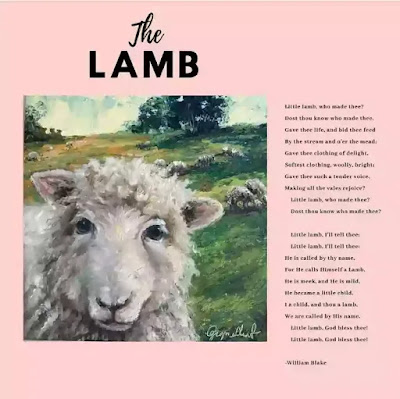Also Read
The Lamb
Summary and Analysis
'The Lamb' is rendered in two different stanzas of which the first includes a few queries put forth by the child, and the rest of the poem answers those questions.
Summary:
A child asks a lamb if it knows its merciful creator, its feeder or the giver of its delightful and cosy clothing of fleece. He also asks the lamb whether it knows who gave it its tender voice that fills the valleys with pleasant joy and music. Quite childlike, the lines.
 |
| The Lamb |
"Little lamb who made thee?Dost thou know who made thee?"
Are repeated, presumable with wonder in the eyes of the child.
The speaker does not wait for any answer. He tells the lamb that its creator is one who is called atter the name of the lamb itself. He is one who calls Himself a lamb. He is meck and mild and came on earth as a little child. The poem comes to have a meaningful pause at this juncture. The questions are asked, answers done and the child (or the poet) turns to conclude the lines in a wise hymnal vein or spiritual implication. He says:
"I a child, and thou a lamb.
We are called by His name:"
In the world of innocence even the meanest creature such as a lamb (which is low only in the eyes of human beings) is treated as having unbound divinity. Here is an exclusive unification of the three characters- Christ, child and the Lamb who constitute the Christian concept of 'Trinity' in the world of innocence.
The Child, Lamb and Christ:
In 'The Lamb' the poet visualizes the holiness of the lamb and child and unifies them with Jesus Christ. It is obvious that the link that connects these three figures is 'innocence'. The harmlessness of the lamb and the purity of the heart of a child are nothing but the manifestation of Christ's innocence. The child harbours no trace of any vicious thought in his, heart nor does he act premeditatedly. The air of innocence is clearly visible on the face of all the three of them.
Biblical Allusions:
More than this element of innocence there is another thread of connection between the lamb and Christ. Christ refers to himself as the lamb of God: "The lamb of God that taketh away the sin of the world". In the Bible Christ is referred to both as a lamb and as a shepherd. In this aspect the lamb has a religious significance too.
Pastoral Elements:
The note of pastoralism, struck first in 'Introduction' is echoed in this poem too. The lamb is associated with pastoralism which in Blake symbolizes innocence and joy. The expanse of pastoral greenery is assigned a peculiar divine air. In 'Introduction' the poet comes to have his angelic vision in the pasture (valleys) and hence its holiness. This holiness asserts itself all through the pastoral setting of the Songs of Innocence.
Conclusion:
'The Lamb' is a significant poem. In this poem the lamb symbolizes the tender, soft and less harsh aspects of human soul. Furthermore, it is a counterpart to the The 'Tyger' in the Songs of Experience. In other words The Lamb and 'The Tiger' represent the two contrary states of the human soul the humility and innocence of childhood and the violent terrifying features of maturity.